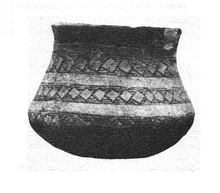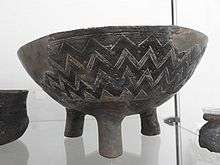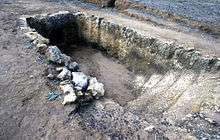Beaker culture in Sardinia
The Beaker culture in Sardinia appeared circa 2100 BC during the last phase of the Chalcolithic period. It initially coexisted with and then replaced the previous Monte Claro culture in Sardinia, developing until the ancient Bronze Age circa 1900–1800 BC. Then, the Beaker culture mixed with the related Bonnanaro culture, considered the first stage of the Nuragic civilization.


Chronology
The European Beaker culture is characterized by the use of classic bell-shaped ceramics. The different styles and decorations of these ceramics allow the Sardinian Beaker culture to be split into three main chronological phases:[1]
- A1 maritime-international phase (c. 2100–2000 BC)
- A2 Italian-Sulcitan phase (c. 2000–1900 BC)
- B undecorated beaker phase (c. 1900–1800 BC)
The various phases show the succession of two main components: the first "Franco-Iberian" (Catalonia and Southern France) and the second "central European" (throughout the Italian peninsula).[2] Thus, it seems likely that the Beaker culture was brought to the island over a long period of time by different waves of immigrants from different regions of Europe.[3] Sardinia was in turn the intermediary that brought Beaker materials to Sicily.[4]

Finds
._Museo_archeologico_._%22Villa_Abbas%22.jpg)
Beaker finds have been found at about seventy sites in Sardinia; they are concentrated mostly along the western coast of the island, from the Nurra region to Sulcis-Iglesiente, and in Campidano, with some outposts in the east, in Dorgali and in the Sarrabus.[5]
Almost all Beaker finds are from burials (generally in pre-existing domus de janas, but also documented from individual burials within stone cists at Santa Vittoria-Nuraxinieddu near Oristano). The objects found include, besides the ceramics, the characteristic brassards (stone wrist-guards) to protect the forearms of archers, flint arrowheads and various ornaments including necklaces made of shells or tusks and buttons with a V-shaped perforation.
Metal objects include copper daggers with a triangular blade and pins. Gold artifacts appeared for the first time on the island (collier from the tomb of Bingia 'e Monti of Gonnostramatza).
Settlements
The old open-air Monte Claro villages disappear almost completely after centuries of occupation (possibly due to climate change[6] or tribal clashes with the newcomers[7]) and only three settlements specifically attributable to this culture are known (Monte Ossoni in Castelsardo, Monte Ollàdiri in Monastir and Palaggiu in Samassi). This could mean that the Beaker bearers were nomadic people dwelling in tents [7] or caves[6] that depended mainly on the cultivation of wheat and the raising of sheep and goats.[6]
Religion
The locations where Beaker people may have performed religious rituals are not known. The discovery of Beaker fragments near the megalithic altar of Monte d'Accoddi does not seem to be related to attendance for religious purposes, but rather indicates the sporadic continuity of activity around a monument already abandoned.
The remains of animals in the tomb of Padru Jossu (Sanluri) suggest sacrifices in honor of a lunar deity[7] or the deceased.
Physical anthropology
Anthropological studies have shown that the Beakers were of a different physical type (roundheads) to the previous inhabitants of the island (longheads).[8]
See also
References
- Ugas 2005, p. 12.
- Ceramiche. Storia, linguaggio e prospettive in Sardegna, Maria Rosaria Manunza, p.26
- Maria Luisa Ferrarese Ceruti, La tomba XVI di Su Crucifissu Mannu e la Cultura di Bonnanaro, in Bullettino di Paletnologia Italiana, nuova serie, XXIII, vol. 81, 1972-1974, Roma 1976, pp. 207
- Salvatore Piccolo, Ancient Stones: The Prehistoric Dolmens of Sicily. Abingdon: Brazen Head Publishing, 2013, ISBN 9780956510624, p. 32.
- Maria Grazia Melis, Usini ricostruire il passato, La necropoli di S’Elighe Entosu e il territorio di Usini in età preistorica e protostorica p.294-295
- Lai 2008, p. 358.
- Ugas 2005, p. 18.
- Germanà, p. 105.
Bibliography
- Ugas, Giovanni (2005). L'Alba dei Nuraghi. Cagliari: Fabula editrice. ISBN 88-89661-00-3.
- Germanà, Franco (1995). L'uomo in Sardegna dal paleolitico fino all'età nuragica.
- Luca Lai - The Interplay of Economic, Climatic and Cultural Change Investigated Through Isotopic Analyses of Bone Tissue: The Case of Sardinia 4000-1900 BC.